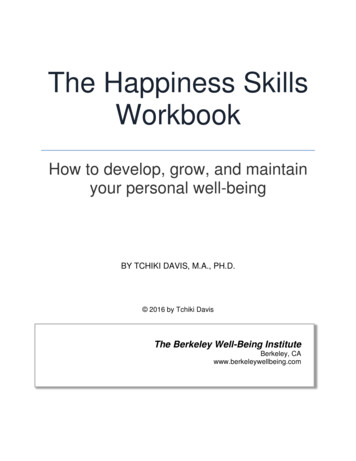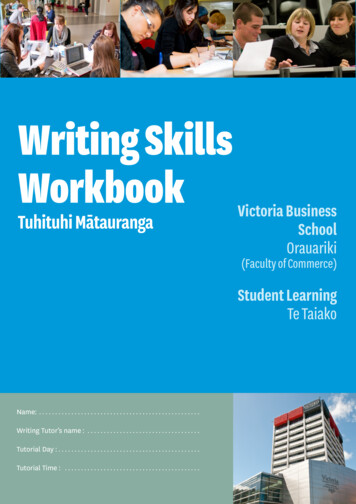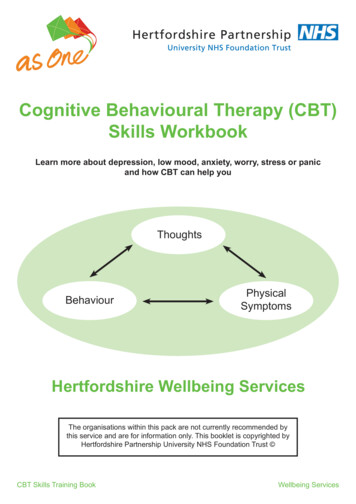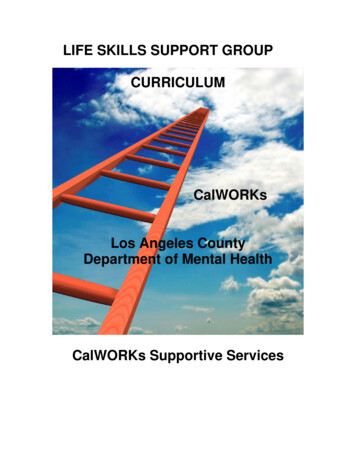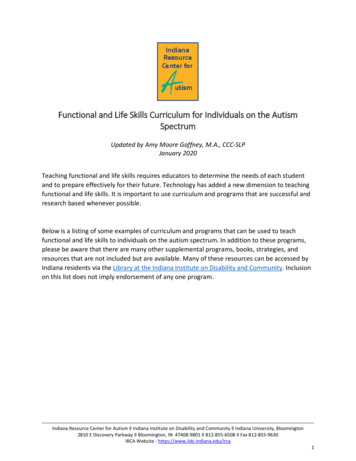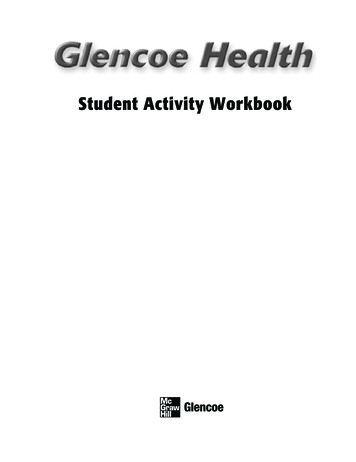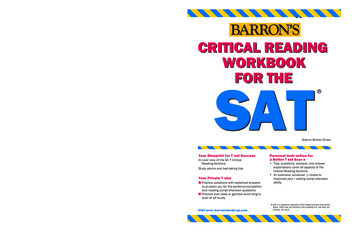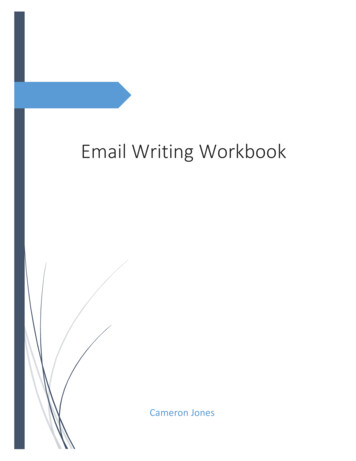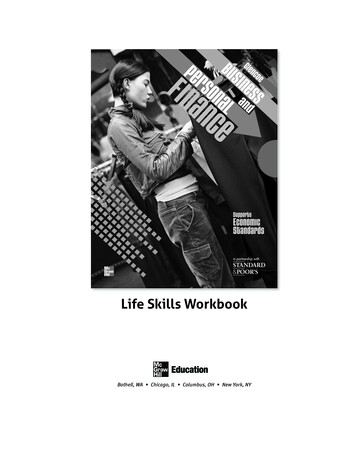
Transcription
00i 0iii BPF SE LSW FM 895836.indd Page i 20/09/11 1:22 AM s-20/Volumes/102/GO00953/LIFE SKILLS WORKBOOK/NATIONAL/ANCILLARY/G1/007 895836 9 P1/Production P1/.Life Skills WorkbookBothell, WA Chicago, IL Columbus, OH New York, NYP rinter P DF
glencoe.comCopyright by The McGraw-Hill Companies, Inc.All rights reserved. The contents, or parts thereof, may bereproduced in print form for non-profit educational useprovided such reproductions bear copyright notice, but maynot be reproduced in any form for any other purpose withoutthe prior written consent of The McGraw-Hill Companies, Inc.,including, but not limited to, network storage or transmission,or broadcast for distance learning.Send all inquiries to:McGraw-Hill Education4400 Easton CommonsColumbus, OH 4321912345678915 14 13 12 11
TABLE OF CONTENTSACTIVITY 1: Consumer Power and ProtectionsACTIVITY 2: Time Management SkillsACTIVITY 3: Consumer Ethics . . . . . . . . . . . . . . . . . . . . . . . . . . . . . . . . . . . .5. . . . . . . . . . . . . . . . . . . . . . . . . . . . . . . . . . . . . . . . .8ACTIVITY 4: Work-Life Balance .ACTIVITY 5: Giving Back. . . . . . . . . . . . . . . . . . . . . . . . . . . . . . . . . . . . . . . 11. . . . . . . . . . . . . . . . . . . . . . . . . . . . . . . . . . . . . . . . . . . . 14ACTIVITY 6: Choosing a Career .ACTIVITY 7: Career Paths. . . . . . . . . . . . . . . . . . . . . . . . . . . . . . . . . . . . . . . 18. . . . . . . . . . . . . . . . . . . . . . . . . . . . . . . . . . . . . . . . . . . 23ACTIVITY 8: Best Practices in the WorkplaceACTIVITY 9: Your Personal FinancesACTIVITY 11: Power of Persuasion. . . . . . . . . . . . . . . . . . . . . . . . . . . . . . 26. . . . . . . . . . . . . . . . . . . . . . . . . . . . . . . . . . . . 29ACTIVITY 10: Needs, Wants, and Values . . . . . . . . . . . . . . . . . . . . . . . . . . . . . . . . . . 32. . . . . . . . . . . . . . . . . . . . . . . . . . . . . . . . . . . . . . 35ACTIVITY 12: Managing Your Resources. . . . . . . . . . . . . . . . . . . . . . . . . . . . . . . . . . 38ACTIVITY 13: The Impact of Technology . . . . . . . . . . . . . . . . . . . . . . . . . . . . . . . . . . 41ACTIVITY 14: Taxes and the ConsumerACTIVITY 15: Being Green . . . . . . . . . . . . . . . . . . . . . . . . . . . . . . . . . . . 44. . . . . . . . . . . . . . . . . . . . . . . . . . . . . . . . . . . . . . . . . . . 47ACTIVITY 16: The Environment . . . . . . . . . . . . . . . . . . . . . . . . . . . . . . . . . . . . . . . . 50ACTIVITY 17: The Impact of the Consumer .Copyright by The McGraw-Hill Companies, Inc. All rights reserved. . . . . . . . . . . . . . . . . . . . . . . . . . . . . .1ACTIVITY 18: Credit Cards .ACTIVITY 19: LoansACTIVITY 20: Debt. . . . . . . . . . . . . . . . . . . . . . . . . . . . . . . . 53. . . . . . . . . . . . . . . . . . . . . . . . . . . . . . . . . . . . . . . . . . . 56. . . . . . . . . . . . . . . . . . . . . . . . . . . . . . . . . . . . . . . . . . . . . . . . 62. . . . . . . . . . . . . . . . . . . . . . . . . . . . . . . . . . . . . . . . . . . . . . . . . 65ACTIVITY 21: Savings . . . . . . . . . . . . . . . . . . . . . . . . . . . . . . . . . . . . . . . . . . . . . . 68ACTIVITY 22: Investing . . . . . . . . . . . . . . . . . . . . . . . . . . . . . . . . . . . . . . . . . . . . . 72ACTIVITY 23: Tax Forms. . . . . . . . . . . . . . . . . . . . . . . . . . . . . . . . . . . . . . . . . . . . . 76ACTIVITY 24: Working Families. . . . . . . . . . . . . . . . . . . . . . . . . . . . . . . . . . . . . . . . 81ACTIVITY 25: The Decision-Making ProcessACTIVITY 26: Insurance. . . . . . . . . . . . . . . . . . . . . . . . . . . . . . . . . . . . . . . . . . . . . 87ACTIVITY 27: Communication.ACTIVITY 28: Stress . . . . . . . . . . . . . . . . . . . . . . . . . . . . . . . . 84. . . . . . . . . . . . . . . . . . . . . . . . . . . . . . . . . . . . . . . . . 90. . . . . . . . . . . . . . . . . . . . . . . . . . . . . . . . . . . . . . . . . . . . . . . 93ACTIVITY 29: Conflict . . . . . . . . . . . . . . . . . . . . . . . . . . . . . . . . . . . . . . . . . . . . . . 96ACTIVITY 30: Life and Career Changes. . . . . . . . . . . . . . . . . . . . . . . . . . . . . . . . . . . 99Life Skills Workbookiii
Name Date ClassActivity 1 Consumer Powers and ProtectionsWhat Are Your Rights as aConsumer?Copyright by The McGraw-Hill Companies, Inc. All rights reserved.Today, you can buy items using yourcomputer, smart phone, or by going to astore. With the variety of optionsavailable, it is critical that you are aninformed consumer, so you can makegood financial decisions. Fortunately,you have help and protections whileshopping in today’s marketplace.In 1962, the Consumer Bill of Rightswas established. It helps ensure thatconsumers can defend themselvesagainst faulty or defective products.Consumers have a right to safe productsand sellers have a responsibility to createand sell safe products. The four basicrights are a right to safety, to beinformed, to choose, and to be heard.And with all rights, comesresponsibilities. Your responsibilities asan informed consumer are to useproducts safely, research and useinformation, choose wisely, contact yourpublic officials about consumer issues,and seek redress.In addition to the bill, there areconsumer protection laws to protect youfrom dangerous products, fraud, ordiscrimination. These laws protect youeven if you are unaware of them. Justlook at food labels in your kitchen.The Fair Packaging and Labeling Actof 1967 required truth in packaging andlabels to help consumers know whattheir food contains and to be able tocompare products.To see another example, look for thewarning label on children’s toys. TheChild Protection and Toy Safety Act waspassed in 1994. It prohibits the sale ofdangerous products intended for sale tochildren and requires a warning label ontoys with small parts.Activity 1AS YOU READ, learn the Vocabulary. AFTER YOU READ, check yourunderstanding through Fact and Idea Review, Critical Thinking Questions, anExtension Activity, and a Research Activity.If you are shopping for a credit card ora loan, you will appreciate the Truth inLending Act. It requires creditors toreport all costs associated withborrowing money in a standardized form.This allows consumers to compare creditcharges and interest rates.These laws are enforced by federal andstate government agencies like theConsumer Product Safety Commission,and the Department of Agriculture. Stateattorney general’s offices have consumerprotection divisions, too. Locally, you cancontact your city or county governmentfor consumer assistance. Private,nonprofit consumer groups such as PublicCitizen, or the local chapter of the BetterBusiness Bureau (BBB) will also work tohelp you resolve your issue. You can file acomplaint with the BBB and they will actas a mediator to help resolve the issue.These laws and agencies ensure thatbusinesses sell safe products and provideredress for consumers. Your attorneygeneral may also offer dispute resolutionthrough arbitration. For example, somestates have “Lemon Laws”. If a consumerbuys a new car and it has a serious defectthat is not corrected by the seller within acertain time frame, then the parties cango to arbitration to decide if the consumeris due a refund.Life Skills Workbook Activity 11
Name Date ClassVocabularyActivity 1redress remedy for a wrong or lossarbitration a procedure in which a neutral person or panel listens to both sides of adispute, weighs the evidence, and makes a decisionFact and Idea Review1. What skills are required to be an effective consumer in today’s marketplace?2. What influence do you as a consumer have on sellers?4. What legal protections do consumers have?5. What forms of redress do consumers have at the state and local level?2Activity 1 Life Skills WorkbookCopyright by The McGraw-Hill Companies, Inc. All rights reserved.3. What rights and responsibilities do consumers and sellers have?
Name Date ClassCritical ThinkingActivity 16. Why do you think there was a movement to have consumer protections? Areconsumer protections still necessary? What do you see as the next trend inconsumer issues?7. How do the consumer protections of the Fair Packaging and Labeling Act and theFood and Drug Administration impact individuals and your family? What do youthink the next consumer trend in labeling will be?Copyright by The McGraw-Hill Companies, Inc. All rights reserved.Extension ActivityIf your verbal complaints are not heard by a retailer, your next step is to write a letter ofcomplaint. Write a letter of complaint to resolve a consumer issue you haveexperienced. As a class, discuss what other forms of redress have consumers. Discusswhat rights and responsibilities consumers and sellers have.Life Skills Workbook Activity 13
Name Date ClassActivity 1Research ActivityDirections Research the agencies and groups and write a brief descriptionof how these groups help consumers. Identify if they are local, state, federal,or private agencies.1. Consumer Product Safety Commission2. Better Business Bureau3. Consumers Union4. Food and Drug Administration6. United States Department of AgricultureWhich of the consumer protection groups would you contact in these scenarios:7. Contractors repaired your roof last week, but it leaks during a thunderstorm.8. You purchased a toy for your nephew that breaks into many small pieces.9. You purchased food that caused you to become ill.10. You want to research a new digital camera before you buy it.4Activity 1 Life Skills WorkbookCopyright by The McGraw-Hill Companies, Inc. All rights reserved.5. Attorney General’s Office
Name Date ClassActivity 2 Time Management SkillsAS YOU READ, learn the Vocabulary. AFTER YOU READ, check yourunderstanding through Fact and Idea Review, Critical Thinking Questions, and anExtension Activity.Planning for SuccessCopyright by The McGraw-Hill Companies, Inc. All rights reserved.One of the first things to do is tocreate a task list. Then set yourpriorities, which task should be donefirst, second, third, and so on. Now youare ready to set goals. It is best to setseveral small goals. You will enjoy afeeling of accomplishment each time youattain one of your goals.Another strategy is to schedule timeto work on your project. When will youwork on task A, B, and C? How muchtime will it take to complete task A, B,and C? When will you do it – afterschool, or work, on the weekend? Bycreating a detailed schedule, you willalso keep your work life and personallife in better balance. You can schedulefree time to help reduce stress. Somedown time will also help you focusbetter when you return to your project.You should also be flexible enough torework your schedule if necessary. If aline of inquiry takes longer to research,you may have to juggle your schedule.Your work environment is also animportant tool to helping you completeyour work. Keep your work space tidyand files organized. Set up yourcomputer, files, and desk for efficiency.Use your computer wisely; downloadcalendars or templates to optimize yourtime management. Labeling file folderswith accurate names and organizingthem by date will help you find themfaster. Once you complete your projectyou can sift through and delete ordiscard files that are no longer useful.Activity 2There is a Chinese proverb that saysthe journey of a thousand miles beginswith the first step. Time management isreally about taking a large overwhelmingtask and breaking it into smaller stepsthat you can accomplish. This is whensome people may procrastinate, but ifyou can create a plan to tackle yourproject, then you will feel more incontrol of your time and the project. Youwill also be more likely to succeed.Conversely, if you have set aside fourhours on a weekend and the task doesnot take that long to complete then youneed to rework your schedule.Keeping good records and organizingyour files is a good habit to start now. Itwill help you when you start working orstart your own business. Just like you,businesses need to manage time andorganize their files and record keeping.Every business must file taxes.Therefore, it is necessary to save all taxrelated forms, payroll and employeebenefits information, and any businessexpenses. In short, businesses must keepany and all information necessary to fillout a tax return or make a claim.You have 24 hours in a day. How youuse that time will decide how much youcan accomplish in a day. Timemanagement skills are key to getting themost out of your day. Remember, it’sreally about taking a lot of small steps toachieve your goal.Life Skills Workbook Activity 25
Name Date ClassVocabularypriorities judgments about the relative importance of alternativesgoals targets for what you want to accomplishprocrastinate to put off taking actionFact and Idea ReviewActivity 21. What tools can help you manage time?2. Describe strategies for time management.Critical Thinking4. Why is time management important to meeting your goals?6Activity 2 Life Skills WorkbookCopyright by The McGraw-Hill Companies, Inc. All rights reserved.3. How can you use time management skills to better balance your family time withschool or work?
Name Date Class5. What time management strategies work best for you and why?6. What time management skills do you need to develop or improve? How could youaccomplish this?Activity 2Extension ActivityCopyright by The McGraw-Hill Companies, Inc. All rights reserved.Compile a list of time management strategies that work best for you. Explain thepurpose and importance o
with the first step. Time management is really about taking a large overwhelming task and breaking it into smaller steps that you can accomplish. This is when some people may procrastinate, but if you can create a plan to tackle your project, then you will feel more in control of your time and the project. You will also be more likely to succeed.

